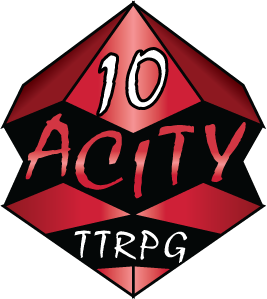Contents:
- Introduction
- Character Sheets
- Step 1: Name, Level, Properties, and Theme
- Step 2: Attributes, Skills, and Impact
- Step 3: Tracking Section
- Step 4: Special Abilities
- Create your own Special Ability
- Equipment
Creating a character in 10acity is fairly simple. There are no classes to choose, so you can build the type of character that you would like without restrictions, though templates are available if you would like to start with one and then just customize it from there.
First, let’s take a glance at the character sheet. Here we have a sample of the blank character sheet, a sample character, and an explanation of the parts of the character sheet. Following this, you can download your own PDF copy of the character sheet or make a copy of a google sheet character builder with built in calculations.
Character Sheets:
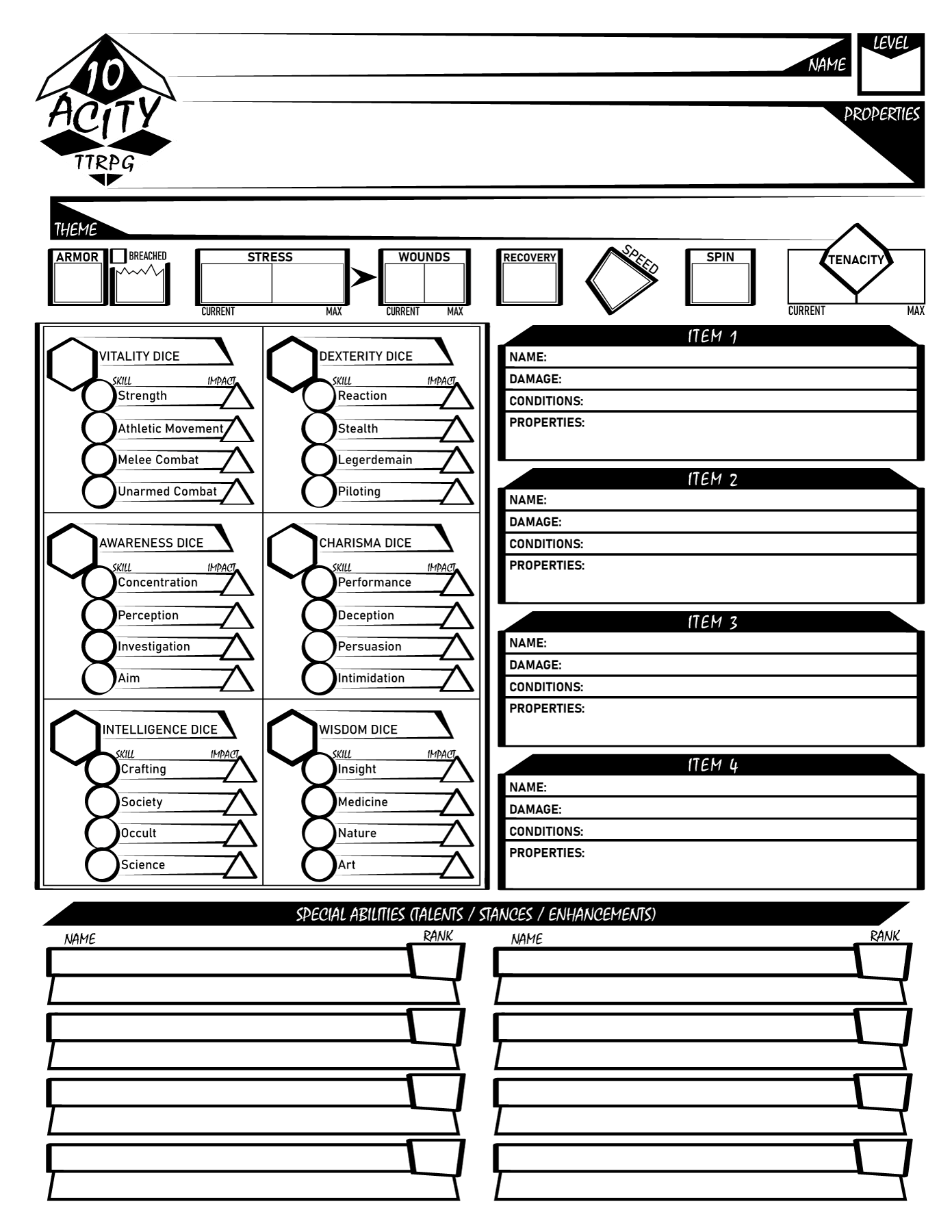
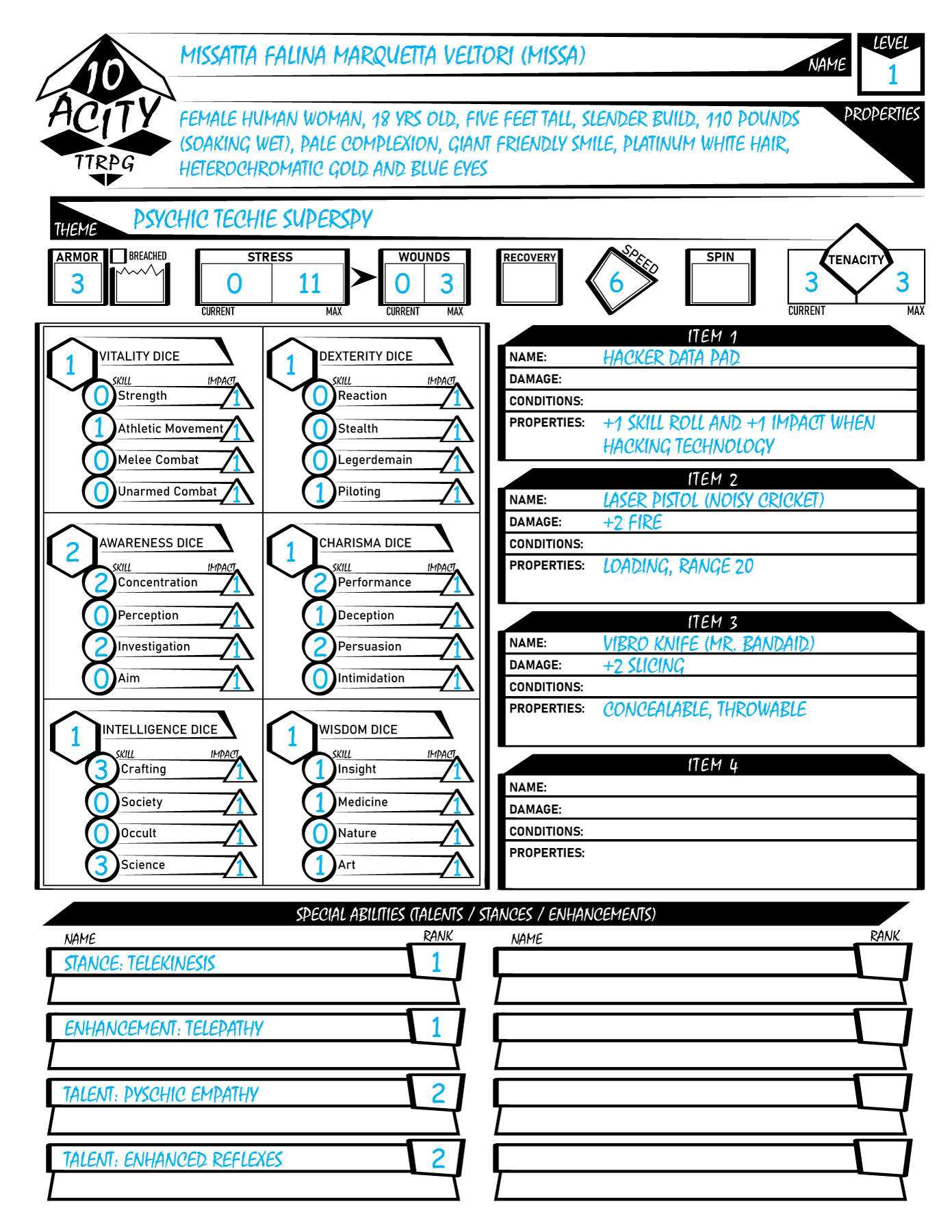
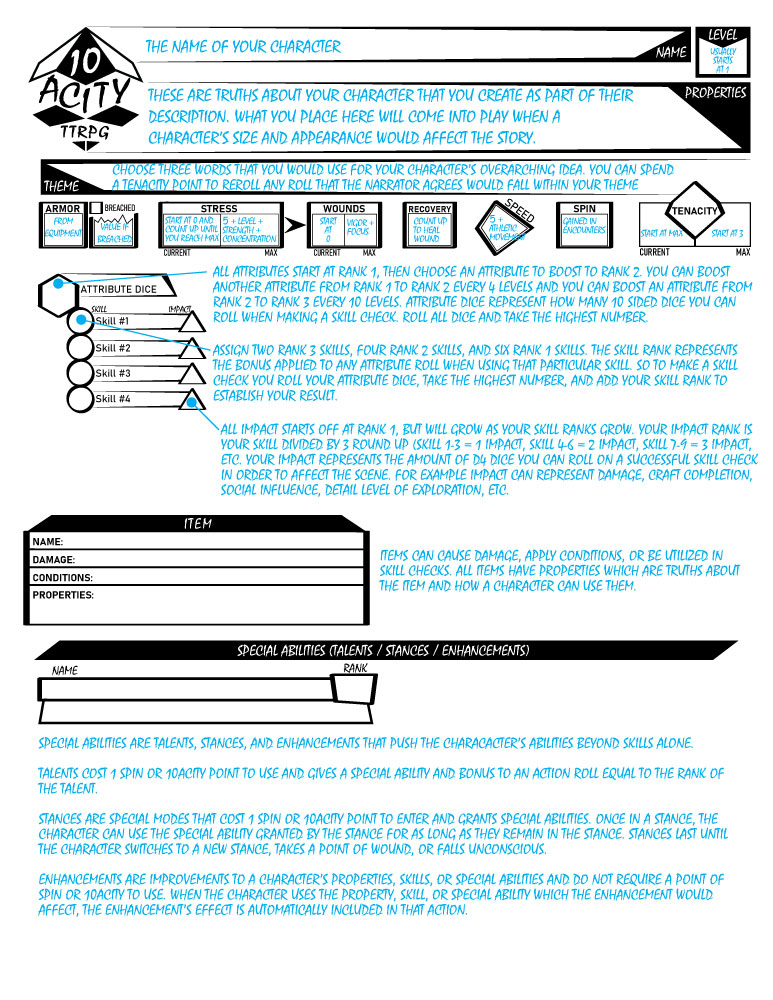
Access a Google Sheet Character Builder with Level Progression here.
(save a copy to your own drive in order to edit.)
Still with me? Great! Now I’ll walk you through a step by step process of building your character.

NAME: This is the name in which your character will be known.
LEVEL: This is the level of your character. In a standard campaign, your character will start at level one, but the narrator may choose to start characters at higher levels if they would like more seasoned characters. For higher level characters, build a level one character then visit the LEVEL UP section to increase their attributes, skills, and special abilities to the appropriate level of experience.
PROPERTIES: These are truths about your character that you create as part of their description. What you place here will come into play when a character’s size and appearance would affect the situation or story.
Size: Choose a size that fits within 1 space
(1-3 meters / 3-10 feet tall) and an appropriate weight.
Body Configuration:
- Biped (2 arms, 2 legs)
- Quadruped (4 legs)
- Insectoid (Multiple legs)
- Serpentine (no legs)
- Other (discuss with Narrator)
Cosmetic Details:
- Body build (thin, lithe, wiry, muscular, hefty, stocky, rotund, etc.)
- Hair or fur and location and coloring
- Skin coloring
- Number of eyes and appearance
- Appearance of ears, mouth, extremities, etc.
- Types of appendages (hands, paws, tentacles, none, etc.)
And of course anything else that you and the Narrator agree on for the description and truths of your character. Any special abilities that your character would have from their appearance (wings, claws, tail, etc.) will be handled by purchasing Talents, Stances, and Enhancements in the Special Ability section of character creation.
Theme: choose three (3) words that you would use for your character’s overarching concept. For example, a samurai might be: Honorable Swordsman Guardian. A gunfighter might be: Infamous Quickdraw Sharpshooter. A hacker might be: Stealthy Ingenious Codebreaker.
This theme represents what your character is known to be good at. Anytime you are attempting an action that is related to your theme and you do not succeed, you can spend a 10acity Point in order to roll again. So if the Samurai was being mind controlled to break his word, he could spend a 10acity Point to use their Honorable theme to reroll his Concentration check. Or if the Hacker was trying to break into an electronic key pad, they could spend a 10acity Point to use their codebreaker theme to reroll their Science check to break in.
Stress, Wounds, Speed, and Tenacity are all values that are determined from the Attributes and Skills that you choose, so we will revisit those once we assign all of our Dice and Skills.
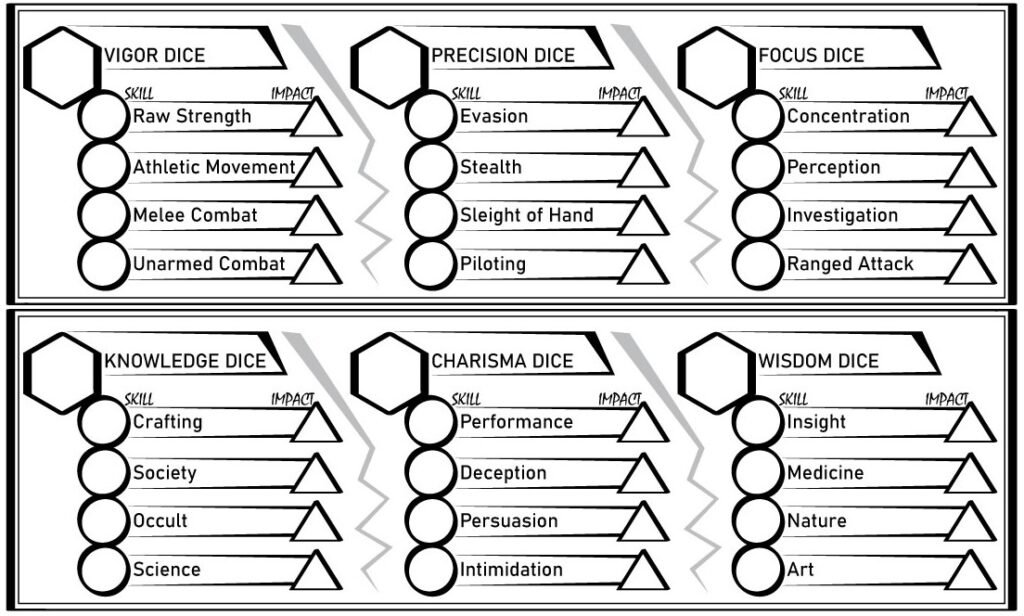
Attributes (Attribute Dice): You start with 1 die in each attribute. Then choose one attribute to be your specialty, increase that attribute to 2 dice. (You will be able to rank up additional attributes in future levels.)
Skills: Choose two (2) skills that you want to be best at performing, assign those skills as rank 3. Choose four (4) other skills that you would like to be good at, assign those skills as rank 2. Choose six (6) other skills that you would like to be familiar with, assign those skills rank 1. (You will be able to choose more skills and rank up existing skills in future levels.)
Impact: All impact die start at rank 1, however this will increase in later levels as your skill rank increases.
Attribute and Skill Definitions:
Attributes are your natural ability at performing a set of skills. This represents the amount of 10-sided dice (d10) that you roll when you are attempting to use one of those skills. If you have more than 1 die, then you roll the number of die that are represented on your Attribute and then take the highest number rolled. So if I had two Attribute dice for the skill I wanted to use, and I rolled a 3 and a 7, my final rolled value would be 7 and then I would add any additional bonuses from skills, equipment, or special abilities to determine my final result.
Skills are your trained abilities to perform actions. When you take an action, choose which skill best fits the action and roll the attribute dice associated with that skill. Then once you have established your highest rolled number, add the ranks of your skill to that number for your final result.
Attributes are divided into six different categories and each category has four skills associated with it:
- Vitality: This is your character’s power in movement.
*Note carrying weight is 100 lbs +20 lbs per rank of Strength OR 100 lbs + 10 lbs per rank of Athletics, whichever is greater. Lift weight is double that, and drag weight is doubled again.- Strength: This is your characters’ ability to move other objects. Feats of strength such as lifting and carrying large burdens, bending steel, breaking bricks, etc.
- Athletic Movement: This is your character’s ability to move themself such as climbing, swimming, jumping, acrobatics, etc.
- Melee Combat: This is your character’s ability to attack and defend with melee weapons. You cannot defend against ranged weapons with a melee weapon without a special ability or special equipment such as a shield.
- Unarmed Combat: This is your character’s ability to attack and defend without using a weapon, they use their own body as a weapon. You cannot defend against ranged weapons with unarmed combat without a special ability or special equipment.
- Dexterity: This is your character’s control and accuracy in their physical motion.
- Reaction: This represents your character’s reflexes and ability to quickly react to the world around them. This is the primary skill used for initiative and dodging attacks.
- Stealth: This is your character’s ability to hide and move without being noticed.
- Legerdemain: This is your character’s ability to move objects deftly with their hands such as juggling, picking pockets, and street magic.
- Piloting: This is your character’s ability to handle forms of transportation from horses and carriages to ships and aircraft.
- Awareness: This is your character’s perception of the world around them and their ability to concentrate.
- Concentration: This is your ability to focus through distractions or external effects. It is the primary defense against mental attacks and used to activate certain special abilities.
- Perception: This is your character’s ability to see the world around them and be aware of their environment.
- Investigation: This is your character’s ability to explore details to find specific results such as looking for a trap on a door or that something has been tampered with.
- Aim: This is your character’s ability to attack using ranged weapons.
- Intelligence: This is your character’s academic knowledge and understanding of how the world works.
- Crafting: This is your character’s ability to create, manipulate, or disassemble objects. Formulas are required to create an item. Simple formulas can be memorized.
- Society: This is your character’s ability to know about the inner workings of societies such as cultures, history, economics, guilds, crime, etc.
- Occult: This is your character’s ability to understand the unknown and unexplainable things in the world such as magic and mysticism.
- Science: This is your character’s ability to understand sciences such as physics, geology, chemistry, computers, etc.
- Charisma: This is your character’s force of personality and ability to affect others.
- Performance: This is your ability to entertain and sway large audiences.
- Deception: This is your character’s ability to lie and quick talk your way through conversations.
- Persuasion: This is your character’s ability to convince others to do what you would like them to do.
- Intimidation: This is your character’s ability to invoke feelings of fear and uncertainty in others.
- Wisdom: This is your character’s sense of intuition and connection to the essence of beings, nature, and art around you.
- Insight: This is your character’s ability to understand and read people and creatures to determine their true intents and emotions.
- Medicine: This is your character’s ability to assess injury and ailment in a person or creature and treat them accordingly.
- Nature: This is your character’s ability to be in touch and understand living nature.
- Art: This is your character’s ability to create works of art that others find appealing and beautiful or stirs some other type of emotion.
Impact is how much effect your action has such as causing damage, completing a craft, how much you sway someone’s opinion, etc. Once you succeed at an action, you roll a number of 4 sided dice (d4) equal to your impact and add all of the numbers together to establish the base number of your effect, then you add any equipment, circumstance, or special ability bonuses in order to determine your final impact.
Your impact die rank is directly tied to your rank in your skill.
Rank 0-3 = 1 impact die
Rank 4-6 = 2 impact dice
Rank 7-9 = 3 impact dice
Rank 10+ = 4 impact dice

Armor: This is equipment that you acquire and wear. It gives additional MAX Stress points.
Breached: Armor can do more than give you additional stress, it can also take wound damage for you. At any point when you would take a point of wound, you can instead choose to have your armor take the damage and become breached. Breached armor only supplies half as much stress until it is repaired. If you choose to have your armor take another point of wound after it is breached it is then destroyed and rendered useless.
Stress: This value is a combination of your Level + Strength Skill + Concentration Skill + Armor. Stress is the representation of how much damage your character can take before they take a point of wound. If at any point you acquire more stress than your Maximum Stress capacity, you must either choose to take a point of Wound damage or fall unconscious. Once you take a point of wound or fall unconscious, your current stress level resets back to 0.
Wounds: This value is a combination of your Vitality Attribute Dice and your Focus Attribute Dice ranks. Wound represents taking so much stress that you have become injured. Wounds are serious and take time and care to remove. When you start an encounter with any amount of wound, then you start with an amount of negative spin equal to your wounds unless you already have more negative spin than your amount of wounds.
Recover: When you are under the care of someone with the medicine skill, you can begin your recover of your wounds. The one giving the care will roll the impact dice of their skill each day and give you that much recovery. It requires 5 times the amount of wounds you have to recover 1 point of wound then the care starts again for the next wound. (So for example: a character with 3 wounds would require 15 recovery to remove a point of wound. A character with 2 wounds would require 10 recovery to remove a point of wound. And a character with 1 wound would require 5 recovery to remove that point of wound.)
Speed: This value is a combination of your Athletic Movement Skill + 5. Speed represents the amount of spaces you can move during your action.
Spin: Spin starts at 0, but will accrue during encounters. Spin represents your ability to spin a situation to your advantage either through tactics or luck. As you gain Spin, you can spend it as if they were temporary 10acity points in order to add bonuses to your actions, your impact, or to activate your special abilities. At the end of an encounter, your spin resets to 0, so don’t be shy about using them.
10acity Points: Your maximum 10acity Points starts at 3, but can be purchased higher using Special Abilities. You regain one (1) 10acity point for every hour of rest you take, but you cannot accrue more than your maximum. 10acity is your character’s inner strength that can be used to fuel special abilities or give bonuses. Call it luck, karma, inner strength, chi, perseverance, maximum effort… whatever you call it. 10acity is a character’s energy that they can tap into to activate their special abilities or to give bonuses to action rolls or to impact.
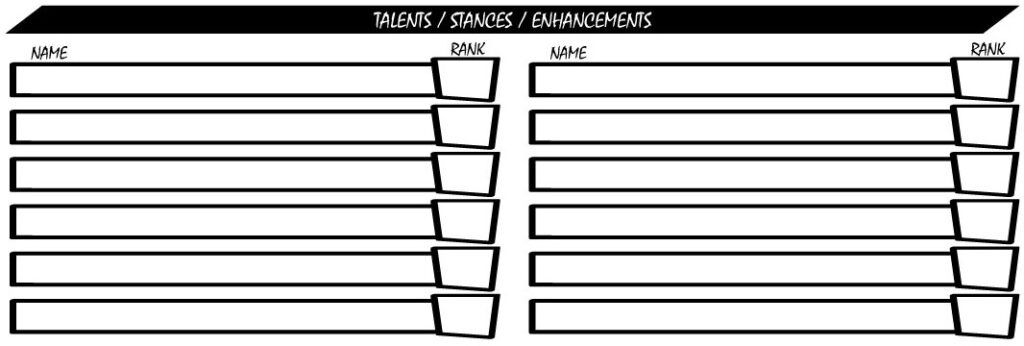
You get to choose 6 ranks of Special Abilities, none of which can be greater than rank 3 at first level. These abilities are separated out into three different categories:
Talents: Talents cost one (1) 10acity Point or Spin to activate and grants special actions and a one time bonus during an action. Talents can have multiple ranks, the higher your rank in a talent, the higher bonus it will grant.
Stances: A stance costs one (1) 10acity Point or Spin to activate a mode that grants the character the special abilities of the Stance. Higher ranked stances give greater abilities while in the stance such as increased range. A Stance ends at the end of an encounter, or if the character takes a point of wound, or if a character falls unconscious.
Enhancements: Enhancements do not cost any 10acity or Spin to activate, they are increased capabilities to already existing abilities or skills and are always active.
If you can’t find a special ability that fits your character, you can always modify and existing one or create one (with the approval of the Narrator). In this section, we’ll share the formulas for creating your own Talents, Stances, and Enhancements.
Talents
Talents are the most powerful of the Special Abilities, this is why they cost 1 Spin/Tenacity for a single action. The basic formula for Talents are:
BONUS + MECHANIC + CONDITION
The BONUS can be additional value added to something the character is doing such as a skill roll or movement (bonuses to impact are rare and if the talent gives bonus to impact it is usually half the talent’s rank). The MECHANIC is the ability to do something that characters can not ordinarily otherwise do. The CONDITION is for balance, if the BONUS and/or MECHANIC is very powerful, then there should be a stronger condition of when it can be used. If the BONUS and MECHANIC is fairly balanced for the cost of a Spin/10acity point, then the CONDITION can be small like when using a particular skill or weapon.
To put this in perspective, a Spin/10acity point alone can add a +1 to a skill roll, a +1 to an impact roll, or reroll an action that is related to the character’s theme. A Talent has to be stronger than that because you are spending character creation points on your ability to perform the talent.
Let’s take a look at a few talents and break them down to see the formula in action:
Point Blank Shot: When attacking with a ranged weapon in melee range, the action still counts as a ranged attack action and can use the Aim skill (normally ranged attacks in melee range count as a melee attack action). Add the rank of this talent to your Aim roll when using a ranged weapon in melee range.
- BONUS: Add rank of this talent to the attack roll.
- MECHANIC: Can use Aim Skill instead of Melee combat.
- CONDITION: When using a ranged weapon.
Rage Strike: When attacking with a melee or thrown weapon, add the rank of this skill to the attack result and add your Strength rank to the damage of this attack up to a limit of 2 damage per rank of this talent.
- BONUS: Add rank of this talent to the attack roll.
- MECHANIC: Can add strength to the damage.
- CONDITION: When using a melee or thrown weapon and only up to 2 damage per rank of this talent.
Frightening Presence: Add the rank of this talent to your intimidation roll. You can intimidate one additional character per rank in this talent, roll each intimidation check separately. When intimidating, you can do it with your appearance alone and do not need direct interaction (it does still take an action), but the characters that are being intimidated must be see or hear you.
- BONUS: Add rank of this talent to the intimidation roll.
- MECHANIC: Can intimidate more than one character
- CONDITION: Intimidators must know you are there via sight or sound.
Pierce Through: When you attack with a ranged weapon, add the rank of this talent to only your first attack roll. Your attack continues on in a straight line through to the next target within the range of the weapon. Roll an additional attack on each target. This piercing attack can continue on this way for a number of targets up to the rank of this talent or the range of the weapon.
- BONUS: Add rank of this talent to the attack roll.
- MECHANIC: Can attack an additional target per rank.
- CONDITION: With a ranged weapon, in a straight line, and the BONUS to attack only applies to the first target.
Stances
Stances are at a power level somewhere between a Talent and an Enhancement. They still cost a Spin/10acity Point to activate, but the stance lasts the entire scene until they either switch to another stance, take a point of wound, or fall unconscious.
Stances do not give BONUS like a talent, it is only a change to the MECHANIC of the game. The formula is only:
MECHANIC + CONDITION
The MECHANIC is the ability to do something that characters can not otherwise do and for an extended duration (for as long as they are in the Stance). That means that you should avoid overpowerful abilities such as granting additional attacks or targets which could unbalance the game. These mechanics should be more of a moderate level. The CONDITION is for balance, if the MECHANIC is very powerful, then there should be a stronger condition. If MECHANIC is fairly balanced for the cost of a Spin/10acity point, then the CONDITION can be small or absent completely.
Let’s take a look at a few stances and break them down to see the formula in action:
Battle Crafting: When using a tool as a melee weapon, attacks and defense can be performed using the [CRAFT] skill instead of [MELEE COMBAT].
- MECHANIC: Can use [CRAFT] instead of [MELEE COMBAT]
- CONDITION: Only when using a tool as a melee weapon
Clairvoyant: When you enter this stance, choose a location within range. While in this stance, you can choose to see or hear as if you were in that location. The range is 10 spaces per rank in this stance and cannot be moved once established without entering the stance again.
- MECHANIC: Can use your senses as if you were in a different location.
- CONDITION: Only see or hear, not both. The location cannot be moved without entering another stance.
Elementalist: Fire: For the duration of this stance, you can sense fire within your range. Spend an action to use [CONCENTRATION] or [OCCULT] to summon or manipulate fire into a desired shape up to the size of 1 space cubed at a range of up to 5 spaces per rank. Once a shape is formed, you can maintain that shape for as long as you remain in the stance. If the form is in the shape of a weapon or a tool, you can hold or wield it as such. For an action you can move that shape up to your rank of spaces or until it hits an object, you can change the shape of the element, or you can release that shape and form another shape within your range. ELEMENTAL FIRE PROPERTIES: Damage: Fire +2, Damaging Condition: Burn, Produces Light and Heat
- MECHANIC: Can summon or manipulate fire.
- CONDITION: Requires an action to use any aspect of the stance. Can only summon or manipulate one shape at a time.
Enhancements
Enhancements are the lowest power. They do not cost Spin/10acity to activate and are always active on the skill or ability that it applies to. They are designed to give small boosts and customizations to characters. The formula is:
SMALL BONUS or MECHANIC + CONDITION
The small Bonus applies to a non-skill or special ability that is otherwise not able to be manipulated like armor, stress, speed, max 10acity points, etc. The MECHANIC is the ability to do something that characters can not otherwise do and that they can always do without expending any points. That means that you should avoid powerful abilities that could be granted by a Talent or a Stance. These mechanics should be more of a minor advantage over another character. The CONDITION is for balance, if the MECHANIC/BONUS is very powerful, then there should be a stronger condition. If MECHANIC/BONUS is fairly balanced, then the CONDITION can be small or absent completely.
Let’s take a look at a few enhancements and break them down to see the formula in action:
Additional Arms: Another pair of arms. This does not give additional actions, but they can hold additional equipment.
- MECHANIC: You have another pair of arms.
- CONDITION: They cannot be used for additional attacks and are really just mechanically utilized for holding additional items for use.
Edict Memory: You do not forget details. You do not need written formulas to craft an item as long as you have had enough time to thoroughly review a formula.
- MECHANIC: Basically a really good memory that allows you to also memorize formulas so that you do not need a way of storing and reviewing formulas.
- CONDITION: Neat, but not game altering, no condition needed.
Fins: You can swim at your movement speed without requiring an athletic roll.
- MECHANIC: You can swim at your regular speed without an athletics check.
- CONDITION: Neat, but not game altering, no condition needed.
Summary
That’s pretty much all there is to it. The list of Special Abilities here is just a baseline of options, but only scratches the surface of what is possible in the 10acity System. So don’t feel restricted, if there is something you’re looking for but can’t quite find, it’s time to alter or create a new one. Take a look at some of the existing Stunts, Stances, and Enhancements for guidelines, then try your hand at altering or building your own. Show it to the Narrator and they may want to alter it a little more on their own based on their own knowledge of the system or their campaign, but once you agree you have a shiny new Special Ability that is all your own.
As your Narrator for your starting wealth and if your society is advanced enough to use modern or futuristic equipment, then use the following list to purchase your equipment.
